Terebess
fűszerkalauz
«
vissza a Terebess Online nyitólapjára
«
vissza a Kertek
és konyhák indexlapra
Thai ízek
Zöldfűszerek
Fűszerek
Gyümölcsök
Zöldségek
Teák
Receptek
Főző
és evőeszközök
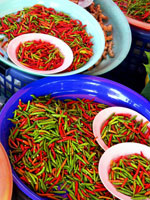
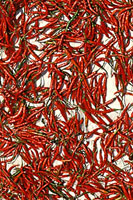
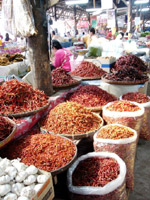
•
Prik
prig,
phrík
csilipaprika
http://infolab.stanford.edu/~widom/photos/chiles.jpg
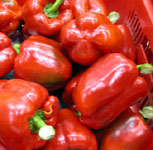
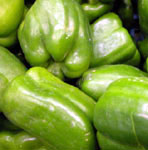
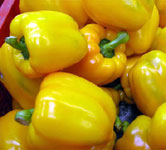
Prik Pasom Sot (Leung-Daeng, Kiew-Daeng, Saam-Daeng)
Yellow and Red Large Bell Pepper, kaliforniai paprika
Bell Chilies - Prik Pasom Sot are sweet-fleshed, bell-shaped members of the chilli family, enjoyed raw or cooked. Unripe green and ripened red or yellow varieties are the most common. Pale yellow, orange, and purple-black types are also available. Italian chillies are slightly sweeter and more slender than regular chillies. Before use, bell peppers must have their indigestible seeds removed. Often the chillies are roasted, which loosens their skins for peeling and enhances their natural sweetness.
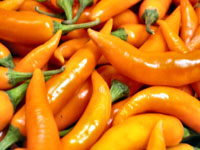
Prik Luang, Prik Leung
Orange Chilli, Yellow Big Chili
Prik Luang, are bright orange, in colour and mild in taste. They are used in Spicy salads and chilli Pastes for their fragrance, and in stir-fried meat dishes for both flavour and aroma.

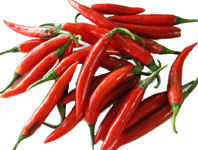
Phrík chii faa, prik csifá
’sky pointing chilli’, ujjnagyságú piros, sárga, zöld csilipaprika
a képeken: Prik Chee-Fa Sot Keaw és Prik Chee-Fa Sot DaengPhrík khii nuu, prik kinu
’mouse dropping chilli’, madárszemű csilifajta, szószerint: egérszar paprika, magyar megfelelője: macskapöcs (Ilyen a népi fantázia, ha egy paprikatőről fakad!)
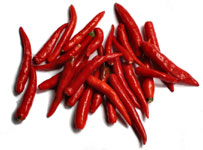
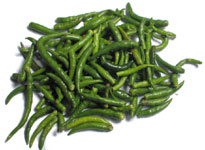
Prik Ki Nu Sot Met Yai (piros Prik-Ki-Nu-Daeng, Prik Ki Nu Sot Met Yai Daeng és zöld Prik-Ki-Nu-Kiew-Met-Yai, Prik Ki Nu Sot Met Yai Keaw)
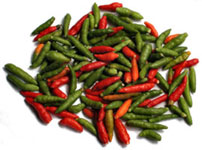
Prik Ki Nu Suan (a legkisebb és legerősebb thai csili)
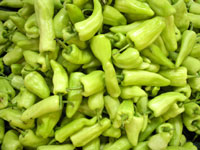
Phrík yuak, Prik Yuak Keaw, prik yuák
banana stalk chilli, leggyakrabban töltött paprikaként használják
Bell Chilies, Prik Yuak, are green, in colour and mild in taste. They are used in Spicy salads and chilli Pastes for their fragrance, and in stir-fried meat dishes for both flavour and aroma.
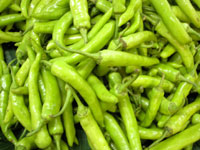
Prik Wan, édes zöldpaprika
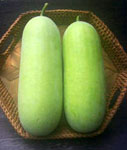
• Fak Keaw
viasztök
Wax
gourd, Fak Keaw, also called white gourd or Chinese preserving melon, is oblong
and light green to white. The ends are rounded and the flesh is solid and white.
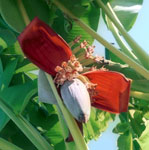
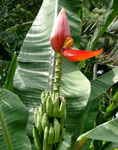
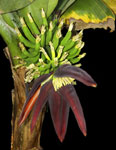
•
Hua plee - Musa
spp.
banánvirág,
banánrügy; banana blossom or bud [angol], jantung pisang [indonéz,
maláj]
Also called banana flowers and banana blossoms, these are in fact the
tender hearts of unopened banana flowers, which have been stripped of their purple
petals. They are available fresh in some Asian markets and also canned or dried.
Fresh banana buds discolour rapidly once they are sliced or shredded, so should
be brushed with lemon juice to prevent this. Banana buds are used in northern
Thailand to make a tasty, squash soup. They are also a popular salad ingredient,
tasting rather like artichokes.
Bai Dong
banánlevél, banana leaf
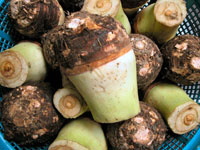
• Puak
Taro
This
root grows wild on the banks of streams in Thailand and is particularly popular
in the north of the country. The swollen tuber is full of starch and is eaten
in the same manner as potatoes. The young leaves can also be eaten. "Wear gloves
when peeling taros".

• Mákuá,
padlizsán - Solanum undatum
A
tömérdek padlizsánfajtából a leggyakoribbak:
-
zöld vagy lila színű, uborka nagyságú - mákuá yáó
- dió nagyságú (levesek,
mártások kísérője) - mákuá kun
- cukorborsó nagyságú törpe padlizsán (mártások,
pörköltek kedvelt ízesítője) - mákuá puan
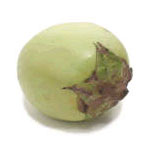
Ma kua Sa Woi
Makheua, ma keua
Thai eggplant, apple aubergines
These small round aubergines are pale green, yellow or white. They are eaten raw with the chilli sauce, nam prik, or cooked in curries. They have little flavour, but when raw have an interesting texture. They discolour rapidly once cut, so drop' them into salted water if you are preparing them in advance.
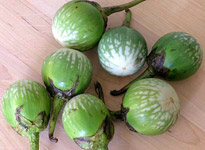
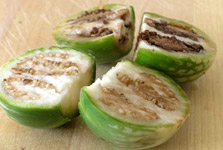
Ma kua Brot
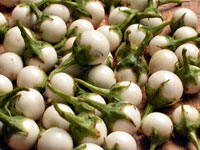
Ma kua Dao Lare
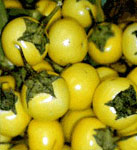
Ma kua Leung
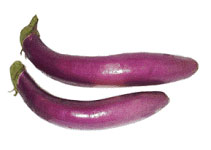
Makheua Yao
Long Eggplant
This elongated variety is similar in appearance and flavour to Japanese long baby aubergines. However, the Thai ones are usually pale green, but can also be purple or white. These aubergines are usually served grilled (broiled) or in green curries.
Makheua Puang
Pea Aubergines
These pea-size berries, which grow in small clusters, have a bitter flavour that is a good foil to the richness of the spicy curries in which they are most often found. They are also used as a flavouring for Nam Prik.
Ma kua Kai Dow
oválpadlizsán
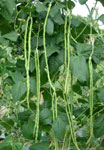
• Thua fak yao - Vigna
sesquipedalis
hosszúbab; long bean, yard-long bean [angol], kacang panjang
[indonéz, maláj], sitaw [filippínó]
These are long, deep green ,string less
beans which grow up to 30-60 cm. Cut in short lengths, they are used in stir-fries,
curries and sometimes soups, They have less flavour than other types of green
beans but are easier to prepare. They have pod up to 60 cm long. These are eaten
both fresh and cooked and are at their best when young and slender.
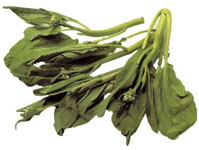
• Pak Kana
thai
(kínai) brokkoli
A dark green vegetable with strong, thin, long round trunks,
soft, deep green delicate leaves, and sometimes tiny white flowers. It does not
look like or taste like the common broccoli. It has a slightly sweet and bitter
taste. Delicious stir-fried, steamed, or boiled but never eaten raw. Most popular
dish is Ka Na Nam Man Hoi which is stir fired with oyster sauce. Unlike regular
broccoli, the stems are usually tender and do not need to be peeled. However,
more mature or larger stalks should be peeled before cooking. It is always smart
to separate the leaves and trunks. The trunks require more cooking time, then
add the leaves near the end, so that they cook evenly. When buying Chinese broccoli,
choose brightly coloured ones with slender thin trunks.
•
Pak Boong
Phak
Bung, mocsári spenót, hajnalka, Swamp Cabbage
This popular leafy plant, also
known as water convolvulus or water spinach, is actually a herb. It grows in marshy
areas, near rivers and canals, and is related to the morning glory that riots
over walls and fences in many European gardens. It has slender, hollow green stems
and thin ovate green leaves which are pointed at the ends. In some parts of Asia,
the stems are pickled, but in Thailand, only the leaves and tender shoots are
eaten. The flavour is similar to that of spinach. In Thailand, the tender tips
are often eaten raw, on their own or with other raw vegetables, and served with
a selection of hot sauces. When cooked, the stem tips stay firm, but the leaves
rapidly become limp. Swamp Cabbage is highly perishable and must be used promptly.

Pak Boong Thai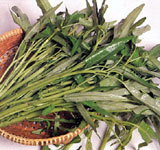
Pak Boong Jin
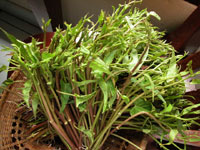
Pak Boong Daeng
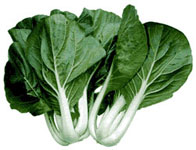
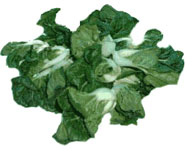
• Bok
Choy
Bok Choy also known as Chinese chard and, has fleshy white
stems, leaf ribs and green flat leaves. It has a slightly mustardy taste. Separate
the leaves, wash well and drain. The white stems can be sliced thinly and eaten
raw. A smaller type is called baby Bok Choy or Shanghai Bok Choy.
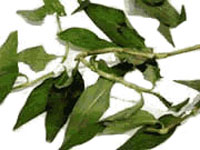
• Pak Preaw; Bai Prik Ma
Pak
Preaw (Bai Prik Ma) is eaten raw with salads or noodles. Pak Preaw can be found
in many Southeast Asian markets
•
Sadao - Azadirachta siamensis
(VAL.), Azadirachta indica var. siamensis Valenton
neem tree,
virágos
hajtását használják főzve zöldségként, nyersen keserű, konzervként is kapható
http://www.fao.org/docrep/006/u5380e/U5380E08.htm
•
Thua phuu; tua phlu
- Psophocarpus tetragonolobus
szárnyasbab; winged bean [angol],
kecipir, kacang botor [indonéz], kacang botor, kacang kelisa [maláj], sigarilyas
[filippínó]
It bears a pod which in cross section looks like a rectangle
that has a fringe-like extension at each corner, the "wings" of the bean.
•
Pak kaet khao-plee - Brassica
pekinensis var. cylindrica
kínai kel; Chinese/celery cabbage [angol], sawi
putih [indonéz], kubis cina [maláj], petsay tsina [filppínó]
Also known as
celery cabbage, this vegetable has soft green and white leaves with a mild, sweet
flavour and crisp texture. It is widely available in supermarkets and is easily
recognized by its fat, cylindrical shape and tightly packed leaves. When buying,
choose specimens that are heavy and firm. Before use, discard any damaged outer
leaves and trim the root. Do not worry if the leaves have small black spots on
them; they are harmless. This type of cabbage keeps well and can be stored in
the salad compartment of the refrigerator for several weeks. It is used in stir-fries,
salads and soups.
Napa Cabbage also known as celery cabbage and Chinese cabbage,
has a long shape and closely packed broad, pale green leaves with wide white stems.
It has a delicate mustard-like flavour. This vegetable always used in Thai stir-fried
vegetable, and Kim Chi.
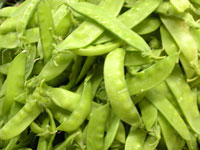
• Thua lantao - Pisum sativum
var. saccharatum
cukorborsó, hóborsó; snow/sugar peas [angol], kacang ercis,
kacang kapri [indonéz], kacang polong [maláj], sitsaro [filippínó]
You eat
these whole, pod and all. They're often stir-fried very briefly (no more than
a minute), but they're also good raw. They're easy to prepare, just wash and trim
the ends. Some people string them as well, but that's not necessary. Select crisp,
flat sugar peas that snap when you break them.
• Yat thua lantao
zöldborsó hajtás
Pea Tips (Yat Tua Lan Tao) are cooked in stir-fries and eaten raw with Nam Prik.
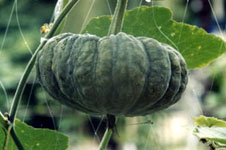
• Fak thong - Cucurbita moschata
pézsmatök
>>>Tovább
Változatos alakú ás méretű, édeskés ízű. A thai konyhában főleg
édességekhez használják. Pürének elkészítve konzervben is kapható.
•
Ka-tin
vadtamarind levél
horse
tamarind leaf
Ka-tin is a vegetable which is eaten raw and has a taste somewhat
like Cha-Om.
Yod-Ka-Tin
Dok-Ka-Tin
Fak-Ka-Tin, Horse Tamarind Pods
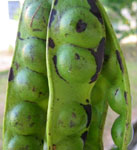
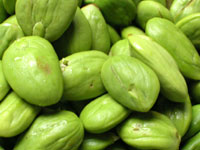
• Sator;
sa-taw - Parkia speciosa
csavarthüvelyű zöldborsó; twisted cluster
bean [angol], petai [indonéz, maláj]
The seeds of a huge tree that grows in
southern Thailand, these beans are about the size of broad (fava) beans. The bright
green pods that house them are flat and wavy. The beans themselves have a peculiar
smell and nutty taste that give a distinctive flavour to regional dishes. The
beans are usually eaten as a vegetable, and they taste good in a sweet-and-sour
stir-fry. They are also sometimes roasted and eaten with Nam Prik, and are made
into pickles.
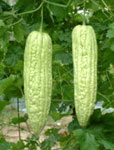
• Mara Jean
bitter melon,
keserű uborka
This tropical, annual vine has bitter taste and is used in, Soup,
curry, and salad. (If you don't like the bitter taste, parboil with salt and rinse
2-3 times before cooking.) The Thais believe that it is very good for the kidneys
and blood. Look for small, firm specimens that are still green when buying. Medicinal
use: Mild laxative, antipyretic, gargle the fruit juice to relieve an aphthous
ulcer.
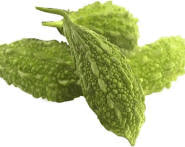
Mara Kae Nok
small bitter melon
•
Pak Kwang Tung Jeen
Chinese mustard
green
Chinese flowering cabbage is slimmer than Bok Choy and has smooth green
leaves and pale green stems with clusters of tiny yellow flowers on the tips of
the inner shoots. The leaves and flowers cook quickly and have light, sweet mustard
flavour; the stems are crunchy and juicy.
The Chinese name for this type of
cabbage is Choi Sum. It is widely grown in the West. The stalks, leaves and yellow
flowers of this plant are all edible and have a delicate flavour. The cabbages
are usually cut into short lengths and used in soups and noodle dishes, but it
may also be stir-fried.
•
Nor mai pai tong
bambuszrügy; bamboo
shoot [angol], rebung [indonéz, maláj], labong [filippínó]
Bamboo shoots are
the crisp, mild-flavoured, "white to ivory" shoots of the bamboo plant. "Crunchy"
in texture and with a subtle, refreshing taste, these are the edible "young" shoots
of certain type of bamboo. The shoots of the bamboo are cut when they have grown
about 15 cm. above the ground. Fresh bamboo shoots are hard to get and, if not
already prepared, before using, peel the skin and boil the inner white part for
30 minutes, to remove toxic "hydrocyanic acid" "boil whole or in chunks" until
they no longer taste bitter. The canned variety needs to be boiled for only 10
minutes. This is a popular ingredient in Thai cooking and can be purchased from
general stores and markets.
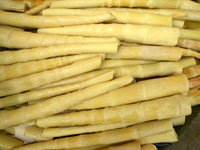
Normai Pai Luag
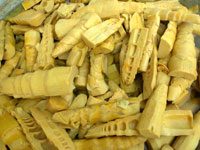
Normai Pai Pa
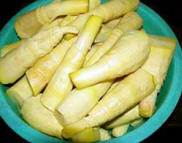
Normai Pai Thong
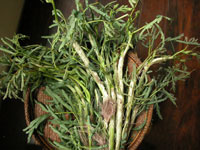
• Pak kra ched
Gra Ched, water mimosa
popular Thai vegetable that is most often cooked in spicy salads or fried with
meats. It is particularly delicious in Gaeng Som soup
•
Raug Bua - Sai Bua
Lotus Root and
Stem
Lotus root is an underwater root that grows to be as long as four feet.
The root is dark reddish brown and needs to be peeled prior to using. The flesh
is a creamy white and tastes similar to coconut. Lotus root is available canned,
dried or candied and can be used as a vegetable or in dessert dishes.
•
Khao Phod On
Baby Corn
Available All
Year, Baby corn refers to "whole", miniature cobs of immature Sweet Corn, no more
than 2-3 inches (5-7.5 cm) long. Corn is a popular vegetable in Thailand. For
stir-fries and soups, Thais prefer baby corn cobs, which have a "musty sweet flavour",
as well as a crunchy texture. They are available fresh and canned. Fresh baby
corn cobs are best eaten soon after purchase but can be stored for up to 1 week
in the salad drawer of the refrigerator.

• Pak Dam Lung
Ivy Gourd, borostyán-levelű
tök
•
Hed Hua Nu - Auricularia spp
fafüle gomba
This
tree fungus has a little flavour of its own, but is valued for is crunchy texture.
It is most commonly available in its dried form, which looks like wrinkled black
paper. Before use, soak in warm water for 15-30 minutes, until the fungus swells
to about five times its size. They should then be rinsed several times to remove
any sand.
•
Hed horm; hed
hom sot - Lentinus edodes
shiitake
mushroom [angol], jamur [indonéz], cendawan [maláj], kabuteng kahoy [filippínó]
Fresh
shiitake mushrooms are available, but Thai cooks prefer to use them dried as they
have a stronger flavour and more texture. Both types are available in supermarkets
and Asian stores. Dried shiitake must be reconstituted in water before being used.
The stems are usually discarded and the caps sliced or chopped for adding to soups
or stews. The soaking water can be strained and used in a soup or stock as it
takes on the flavour of the shiitake. The dried mushrooms will keep well if stored
in a sealed plastic tub or bag in a cool, dry place. They are also called Chinese
dried black mushrooms. Their distinctive woody, smoky tastes are intensified by
the drying process and they are rarely eaten fresh.
•
Hed fang - Volvariella volvacea
Rizsszalmás
bocskorosgomba; straw mushroom [angol], kabute [filippínó]
These delicate,
sweet flavoured mushrooms have acquired their English name because of the method
of cultivation on beds of straw. They look like miniature helmets and are the
most popular variety of mushroom in Thai cooking. Straw mushrooms are used extensively
in soups, salads and curries, and taste particularly good with prawns (shrimp)
and crab meat. Canned straw mushrooms are widely available from Asian stores and
many supermarkets. They have neither the exquisite flavour nor the texture of
the fresh mushrooms, but can be an acceptable substitute. Fresh straw mushrooms
are highly perishable and so are not often available in the West. If you do locate
them, use them as soon as possible after purchase.
•
Haeo (Kra juab)
Water Chestnuts, csetkáka-gumó,
vízigesztenye
These white-fleshed roots of a variety of water grass are prized
for their semi-sweet taste and crisp texture, which is retained when cooked. They
are used throughout China and Southeast Asia in both savoury and sweet dishes.
Available canned and sometimes fresh. Cut off the woody base, peel away papery
skin, and cover in water to stop discolouring.
•
Ga-Jab
Water Caltrop, Horned Water
Chestnut, sulyom
This black nut bears an unmistakable resemblance to a bull's
head. Each one is about two inches across, and has a very hard shell. After you
shell water caltrops, you'll need to steam or boil them before you can eat them
as they contain harmful toxins in their raw state. Or you can skip eating them
altogether, and just use them to make jewellery. Substitutes: water chestnuts
(crunchier and sweeter)
•
Man
Tet
Boniato (Mun Tet) is primarily used in making Thai desserts. Boniato, as well
as taro, is available at many Asian markets.
•
Sa-Mek
Sa-Mek
is a vegetable that has a citrus flavour and is eaten fresh with salads such as
Larb or Nam Kluke (Fried Rice Cake)
•
Tia To
Tia To also has a citrus-like flavour
but very different from sa-mek. It's eaten raw with nam prik or salads.
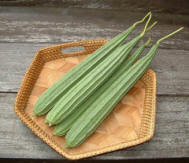
• Buap Liam
Angle Loofah
Available
All year, Also known as silk gourd, silk squash or Chinese okra, this dark green
vegetable looks like a long, thin courgette (zucchini) or a very large okra pod,
and has angular ridges down its length. A close relative, the smooth loofah is
paler in colour, larger and more cylindrical, with a slightly thicker base. Both
have a very mild taste, similar to cucumber, which can be used in its place in
most cooked dishes. The gourds are eaten young, while they are still sweet. They
become unpleasantly bitter as they mature. Angled Loofah is used in stir-fries
and soups, and is often boiled and eaten with nam prik.
•
Tua
Ngok
Bean
Sprouts, babcsíra
The most often used bean sprouts in Thai cooking are the
small "green" sprouts from Mung beans and the larger "yellow" sprouts from Soya
beans. Soya beansprouts have a stronger flavour than Mung beansprouts, but both
are relatively delicate, with a pleasant and unique crunchy texture. Fresh beansprouts
are widely available in supermarkets, health-food stores and Asian food stores,
or you can easily sprout your own beans at home. Avoid canned beansprouts as they
are flaccid and tasteless.
•
Tua-Rea
szója-zöldbab, Vegetable Soya
Bean
Soy bean plants or Tua Rea in Thai, are very much like Lima beans in
flavour. The beans are buttery, sweet and delicious. For a quick snack, steam
the pods in boiling water for five minutes, allow to cool and the beans will pop
right out of their pods with the slightest pressure. In Thai cuisine they are
used in stir-fry's.
•
Hua Chai Tao; Hua Pak Kat
jégcsapretek,
Chinese Radish
Thais value this vegetable, believing that it aids digestion,
cools the body and improves blood circulation. Also called giant white radish
or winter radish, it is a long white root that resembles a slender, smooth-skinned
parsnip in appearance. It can be up to 40cm / l6in long, although the Thai variety
is often considerably smaller. Large specimens tend to be fibrous and should be
avoided. When raw, the flavour is a mixture of cool, sharp and peppery, and the
texture is crisp. Thais don't often eat it this way, but the grated flesh is sometimes
used to tenderize seafood. When the vegetable is cooked, the characteristic texture
is retained, but the flavour becomes quite sweet.
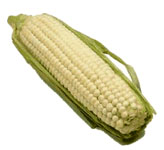
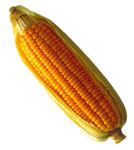
•
Kao Phod Khao - Kao Phod Wan
fehér és
sárga csemegekukorica, Sweet Corn
This is the only grain that's commonly eaten
as a fresh vegetable. Native to the Americas, corn is a great source of vitamin
A, fibre, and other nutrients. When corn comes into season during the summer,
it's common to see people in supermarkets peeling back husks in search of ears
with perfect rows of kernels. Don't do that yourself. Crooked rows taste just
as good as straight, and keeping the husk on helps the corn stay sweet. Freshness
is a better criterion, since the sugars in corn begin converting into starch the
moment it's picked.
•
Man Sam Pa Lang
Cassava Root
Yucca
Root (Man Sam Pa Lang) is primarily used in making Thai desserts. Yucca is also
called tapioca or cassava.

• Nor-Mai Farang
Asparagus
Available All year, Asparagus are long, slender vegetables that grow as shoots
in spring and early summer. The straight, firm stalks, which range from pencil
thin to as thick as your thumb, are prized for their delicate flavour; the "tender
tips" have a particularly delicate flavour and texture. The most common variety
is green and sometimes tinged with purple at the bud. White and purple stalk varieties
are also available. Look for asparagus with crisp, straight stalks and tight buds.
Wrap in damp paper towels and refrigerate in a plastic bag for up to 4 days. Trim
the stalks before using. Cut or snap off the tough ends and discard. If desired,
peel the bottom third or half of each stalk with a vegetable peeler for a more
tender texture.
•
Hua Pak Got Kao
Daikon Radish
(Hua Pak Got Kao) is used in soups and stir-fries.
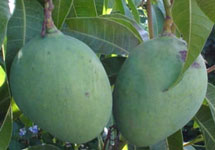
• Ma-muang dib
- Mangifera spp.
zöld mangó; green mango [angol], mangga [indonéz, maláj, filippínó]
Green
mango is eaten raw with spicy dipping sauce for a sour sensation or is shredded
for salad.
Mamuang Nam Pla Wan - Thai Green Mango with Sweet Fish SauceA fragrant Thai classic, The mango used for this recipe must be hard, green on the outside, with whitish/green flesh, and sour taste. In Thailand it's very common to find green, sour mango.
Ingredients
10 green mangoes
1 lb palm sugar
1/4 cup water
1/4 cup fish sauce - nam pla
1/2 cup chopped shallots
1/2 cup dried shrimp, ground up in a food processor or pounded in a mortar and pestle
2 finely sliced hot chili peppersMethod
1. Mix palm sugar, water and fish sauce in a pot and simmer over low heat, stirring constantly.
2. When the mixture has become a thick syrup, add the shallots.
3. Cook until shallots are tender.
4. Remove from heat and blend in dried shrimp & chili peppers.
5. Stir well, and set aside1. Peel the mangoes and cut into thin slices (approx 1/4", but be careful not to cut them too thin).
2. Place the mango slices in a container and chill in the fridge to improve flavour and crispiness.Serving
Put mango on a serving tray with the sauce on the side.
Dip mango slices into the sauce, eat and enjoy!
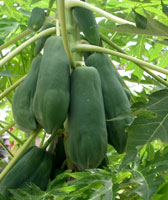
• Ma-la-kaw dip -
Carica papaya
zöld papaja; green papaya [angol, indonéz, filippínó], betik
[maláj]
Green
Papaya - Ma-La-Khor Papaya (Malagor dip) is a tropical fruit with a smooth,
yellow skin and soft, sweet orange flesh that is milder tasting than a mango.
Other shapes and colours of papaya are also grown. Halve a papaya lengthwise and
scoop out shiny black seeds before peeling. In Thai cooking, young green papaya
is used to make salad or Som Tam, a popular salad dish among foreigners in Thailand.
You may be in difficulty in finding fresh green papaya outside Thailand. The fresh
carrots or cabbages or green apples can be used as a substitute.
•
Gra-Jiab
Okra
is deep fried, cooked in sour curry (gang som) and is eaten raw as an accompanying
vegetable to nam prik dishes.
Yod Gra-Jiab Daeng
okralevél, okra leaves